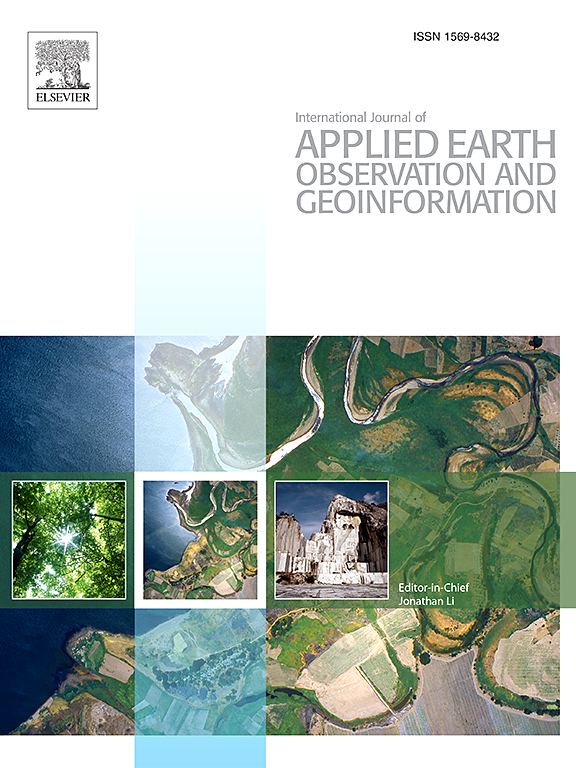GPP estimation by transfer learning with combined solar-induced chlorophyll fluorescence and eddy covariance data
IF 7.6
Q1 REMOTE SENSING
International journal of applied earth observation and geoinformation : ITC journal
Pub Date : 2025-04-13
DOI:10.1016/j.jag.2025.104503
引用次数: 0
Abstract
Gross primary productivity (GPP) plays a crucial role in the carbon exchange between the atmosphere and terrestrial ecosystems. Eddy covariance (EC) method can obtain accurate GPP at the site level, but the sparse distribution limits representativeness. Satellite solar-induced chlorophyll fluorescence (SIF) serves as emerging data of large-scale GPP, yet there are still limitations in its conversion to GPP and spatiotemporal coverage. This study proposes a transfer learning (SIFEC-TL) method to estimate long-term global GPP with high accuracy by combining constraints from SIF and EC data. SIF data are taken as the source domain that provides the spatial information for pre-training, and EC GPP in the target domain provides precise GPP for the machine learning model fine-tuning. To verify the performance of SIFEC-TL, the results are compared with those from machine learning models that use only SIF or EC GPP alone (SIFML and ECML). The results indicate that the SIFEC-TL model demonstrates stronger spatial scalability compared to the SIFML and ECML models, with R2 increasing by 0.132 and 0.036. The SIFEC-TL more effectively captures inter-annual GPP dynamics with underestimation/overestimation over high/low values in the SIFML and ECML models being well corrected. Furthermore, three different SIF-based GPP are also used as source domains, and the results showed that they only affect pre-training but the final accuracy after fine-tuning remains similar, which indicates SIFEC-TL can obtain stable GPP estimation accuracy regardless of the spatiotemporal coverage of SIF data and its conversion to GPP.
结合太阳诱导叶绿素荧光和涡动相关方差数据的迁移学习估计GPP
总初级生产力(GPP)在大气与陆地生态系统之间的碳交换中起着至关重要的作用。涡度协方差(EC)方法可以获得准确的地点级 GPP,但分布稀疏限制了其代表性。卫星太阳诱导叶绿素荧光(SIF)是大尺度 GPP 的新兴数据,但其在转换为 GPP 和时空覆盖方面仍存在局限性。本研究提出了一种迁移学习(SIFEC-TL)方法,通过结合 SIF 和 EC 数据的约束条件来高精度估算长期全球 GPP。SIF 数据作为源域为预训练提供空间信息,目标域的 EC GPP 为机器学习模型的微调提供精确的 GPP。为了验证 SIFEC-TL 的性能,将其结果与仅使用 SIF 或 EC GPP 的机器学习模型(SIFML 和 ECML)的结果进行了比较。结果表明,与 SIFML 和 ECML 模型相比,SIFEC-TL 模型具有更强的空间可扩展性,R2 分别增加了 0.132 和 0.036。SIFEC-TL 模型更有效地捕捉了年际 GPP 动态变化,SIFML 和 ECML 模型对高/低值的低估/高估得到了很好的纠正。此外,还使用了三种不同的基于 SIF 的 GPP 作为源域,结果表明,它们只影响预训练,但微调后的最终精度仍然相似,这表明无论 SIF 数据的时空覆盖范围及其转换为 GPP 的情况如何,SIFEC-TL 都能获得稳定的 GPP 估计精度。
本文章由计算机程序翻译,如有差异,请以英文原文为准。
求助全文
约1分钟内获得全文
求助全文
来源期刊

International journal of applied earth observation and geoinformation : ITC journal
Global and Planetary Change, Management, Monitoring, Policy and Law, Earth-Surface Processes, Computers in Earth Sciences
CiteScore
12.00
自引率
0.00%
发文量
0
审稿时长
77 days
期刊介绍:
The International Journal of Applied Earth Observation and Geoinformation publishes original papers that utilize earth observation data for natural resource and environmental inventory and management. These data primarily originate from remote sensing platforms, including satellites and aircraft, supplemented by surface and subsurface measurements. Addressing natural resources such as forests, agricultural land, soils, and water, as well as environmental concerns like biodiversity, land degradation, and hazards, the journal explores conceptual and data-driven approaches. It covers geoinformation themes like capturing, databasing, visualization, interpretation, data quality, and spatial uncertainty.
 求助内容:
求助内容: 应助结果提醒方式:
应助结果提醒方式:


